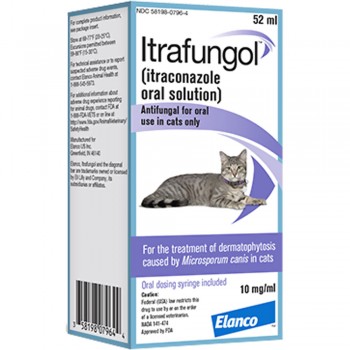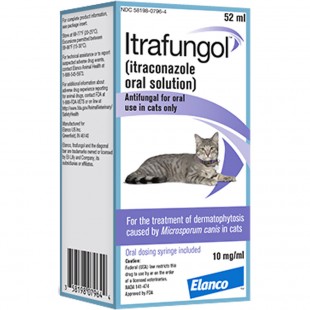
Itrafungol Oral Solution for Cats 52ml + syringe
Itrafungol is used for the treatment of ringworm in cats caused by Microsporum canis. VET PRESCRIPTION REQUIRED



Itrafungol is used for the treatment of ringworm in cats caused by Microsporum canis
Itrafungol contains the active ingredient itraconazole and is available in the following strengths: 52ml Itrafungol
Itrafungol is a yellow to slightly amber, clear oral solution containing 10 mg itraconazole per ml. Other ingredients include propylene glycol, sorbitol and caramel (E150). Itrafungol is administered orally, directly into the mouth by means of the enclosed graduated dosing syringe.
A Veterinary Pet Prescription is required for Itrafungol
Ringworm in cats
Ringworm is the name given to a skin condition rather than an actual worm, and as such, the very name is rather misleading! Ringworm is classed as a zoonotic condition, meaning that it can cross the species boundary with ease, and be pa...
Itrafungol is used for the treatment of ringworm in cats caused by Microsporum canis
Itrafungol contains the active ingredient itraconazole and is available in the following strengths: 52ml Itrafungol
Itrafungol is a yellow to slightly amber, clear oral solution containing 10 mg itraconazole per ml. Other ingredients include propylene glycol, sorbitol and caramel (E150). Itrafungol is administered orally, directly into the mouth by means of the enclosed graduated dosing syringe.
A Veterinary Pet Prescription is required for Itrafungol
Ringworm in cats
Ringworm is the name given to a skin condition rather than an actual worm, and as such, the very name is rather misleading! Ringworm is classed as a zoonotic condition, meaning that it can cross the species boundary with ease, and be passed back and forth between a range of animals including dogs, wildlife and humans, as well as cats.
Ringworm can be all too easy to catch, and challenging to fully eradicate in cats, and so in this article, we will look at feline ringworm, how cats catch it, and how it can be cured in more detail. Read on to learn more.
What is ringworm?
Ringworm is a skin condition that is caused by infection with a fungal parasite, which is very contagious between mammals. The scientific name for ringworm is Dermatophytosis, and this type of fungus lives on keratin, a protein compound present in the skin, hair and nails of both people and animals. Ringworm thrives in slightly warm, moist environments, making the skin of your cat the perfect host.
It is important to remember that ringworm is a skin condition and not a parasitic or intestinal worm, and as such, it is treated and eradicated in a different way, and standard worming treatments such as you might give for intestinal worms will not have any impact on it!
How do cats catch ringworm?
Ringworm is mainly transmitted by skin-to-skin contact, such as if your cat comes into contact with another cat, dog or person that has the condition. However, other surfaces that infected animals have come into contact with, including bedding, food bowls and furniture can also potentially transmit ringworm spores, and so using fungicidal detergents to treat your whole home and everything in it is advisable when tackling an outbreak of ringworm on your cat or another person or animal in your home.
How would I know if my cat had ringworm?
Ringworm is relatively easy to identify on the cat, and once you have seen it, you will definitely be able to spot it again. The presentation of ringworm in cats usually proceeds as follows:
How is ringworm diagnosed?
If you know or suspect that your cat has ringworm, you will need to take them along to your vet for a check-up. Your vet may diagnose ringworm on the basis of the physical presentation of the condition alone, but generally, they will use a special fluorescent lamp to examine the skin and identify the fungus, or perform a microscopic examination of hair follicles from affected patches.
Once your vet has diagnosed ringworm, they will be able to advise you on the best course of treatment for your cat, as well as how to take care of your cat’s treatment at home and minimise the chances of the condition spreading to your family or other animals.
Treating ringworm
The actual process of treating your cat for ringworm is relatively simple; the hard part, however, is eradicating the presence of the infection from your home and possibly your other animals, and preventing reinfection!
Anti-fungicidal medications such as Imaverol or Itrafungol oral solutions, or Malaseb antifungal shampoo are generally prescribed to treat ringworm in cats, or your vet may recommend using a topical antifungal cream, either as well as or instead of other options. If your cat has particularly long or thick fur, your vet may recommend clipping them while they are under treatment, to make it easier to access the skin and give the ringworm spores less places to hide.
When treating your cat’s ringworm, you should wear gloves and always wash your hands and arms thoroughly with an antifungal wash afterwards, to prevent contracting the condition yourself, or reintroducing the infection once your cat’s condition is clearing up.
You should also ensure that all of your cat’s bedding, bowls and all soft furnishings that your cat comes into contact with are thoroughly cleaned with an anti-fungicidal wash as well. If you do contract ringworm as a result of treating your cat, do not panic! Visit your doctor for a course of treatment for yourself, as ringworm can be resolved relatively simply in humans as well.



Itrafungol is used for the treatment of ringworm in cats caused by Microsporum canis. VET PRESCRIPTION REQUIRED


